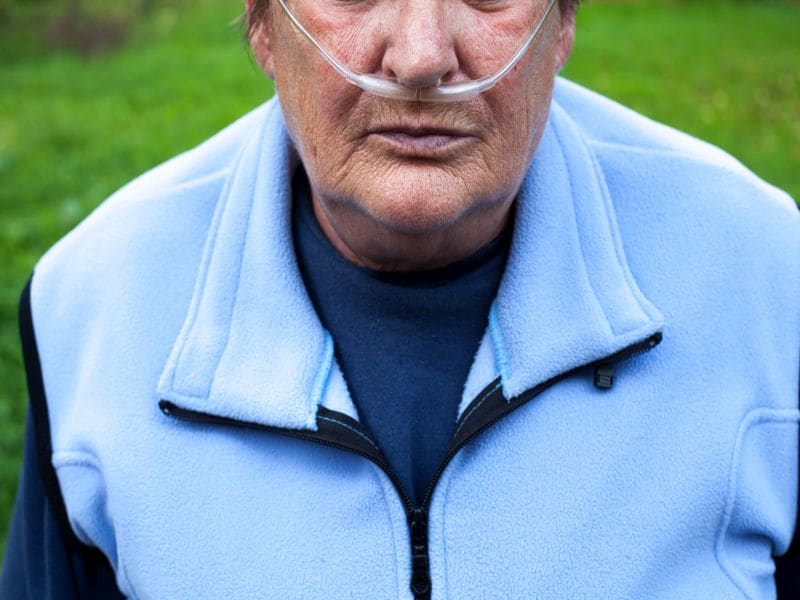THURSDAY, Nov. 15, 2018 (HealthDay News) — Chronic obstructive pulmonary disease (COPD) remains the fourth biggest killer in the United States. But only a fraction of the millions of people who could benefit from post-hospital rehab for COPD are doing so, new research shows.
COPD is a progressive, debilitating and incurable respiratory illness, often tied to smoking. Many patients require supplementary oxygen to live normal lives.
As explained by researchers at Baystate Medical Center in Springfield, Mass., pulmonary rehabilitation aims to give patients exercise training, self-management advice, nutrition counseling and emotional support. It’s been shown to boost patients’ physical and mental health, and overall quality of life.
But far too few may be receiving it.
In the new study, researchers reviewed the records of nearly 224,000 Americans hospitalized for COPD in 2012. The investigators found that only 1.9 percent received pulmonary rehabilitation within six months of being discharged from the hospital.
And by one year after hospital discharge, that number had risen only slightly, to 2.7 percent, the team reported. The findings were published online Nov. 12 in the Annals of the American Thoracic Society.
Of the patients who started pulmonary rehabilitation, more than half completed at least 16 sessions, the study found. Medicare will typically pay for up to 36 sessions.
A ‘critical’ part of care
“Unfortunately, many patients face multiple barriers to participating, such as family responsibilities or transportation, and participation rates are especially low among vulnerable populations,” said study lead author Kerry Spitzer, a clinical researcher at Baystate.
“We have a lot to learn about how hospitals can help address these challenges,” she explained in a journal news release.
Pulmonologist Dr. Ann Tilley noted that “the findings of this study are really distressing — enormous numbers of patients with COPD, who would benefit from pulmonary rehabilitation, are not receiving it.”
According to Tilley, who practices at Lenox Hill Hospital in New York City and was not involved with the study, “Pulmonary rehabilitation is a critical component of care for COPD patients and is something I spend a lot of time talking to my own patients about. I would say to COPD patients, if your doctor recommends a pulmonary rehabilitation program, strongly consider going!”
In the study, whites, males, younger patients and those on home oxygen were among those patients likely to receive pulmonary rehabilitation. Patients were less likely to receive the rehabilitation if they were smokers; lived more than 10 miles from a pulmonary rehabilitation program; were poorer; or had other chronic diseases and prior hospitalizations.
Tilley said it’s true that in her clinical practice, “the farther patients live from a pulmonary rehabilitation program, the less likely they are to attend. We in the healthcare community need to do more to remove barriers like this.”
Dr. Theodore Maniatis is a pulmonologist and medical director at Staten Island University Hospital in New York City. Reading over the study findings, he said there are numerous complex reasons why uptake of COPD rehab is so low.
One could be problems financing new rehabilitation centers, he suggested.
“Medicare reimbursement for services does not mean that it is easy or profitable to set up a pulmonary rehabilitation center, because there are a critical number of patients needed to make such a program sustainable,” Maniatis said.
Pulmonary rehabilitation typically requires three visits per week over several weeks. If enough patients cannot or will not engage in these programs, centers can’t remain financially viable, he said.
Maniatis stressed that there’s been no clear evidence that these programs actually extend the lives of people with COPD. But “what is much clearer is that participation in such a program does reduce fatigue and shortness of breath, and increases in exercise tolerance. And it improves quality of life,” he said.
Life-changing benefits
“Pulmonary rehabilitation means the complete rehabilitation of the pulmonary disease patient, including changing lifestyles,” Maniatis said. “That includes discontinuation of smoking, using oxygen when necessary, understanding and utilizing medications to prevent exacerbations of lung disease and changing the medication treatment when exacerbations of lung disease do occur.”
Exercise aimed at bolstering patients’ ability to move and breathe is also key.
Other components of rehab focus on the mental well-being of patients, “by fostering a sense of independence and socialization with other patients” facing the same challenges, Maniatis said.
The program can really pay off, he believes.
“Pulmonary rehabilitation programs have been shown to decrease the number of exacerbations and therefore readmissions to hospitals,” Maniatis added.
For her part, Tilley said more patient outreach is key.
“It’s probably true that some doctors fail to recommend rehab, and that some patients decline to go when it is recommended,” she said.
“If your doctor doesn’t recommend rehab to you, ask her about it,” Tilley said. “The benefits can truly be life-changing.”
And don’t give up too easily, she said. “I recommend that my own patients give it at least two sessions before deciding if it’s not for them,” Tilley noted.
The study was funded by the U.S. National Heart, Lung, and Blood Institute.
More information
The COPD Foundation has more on pulmonary rehabilitation.
Copyright © 2025 HealthDay. All rights reserved.

